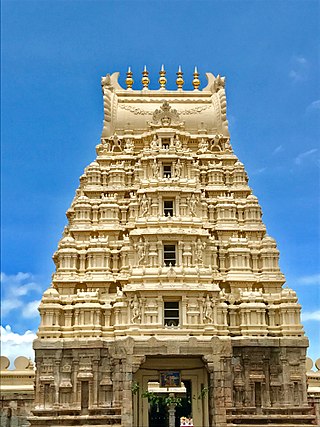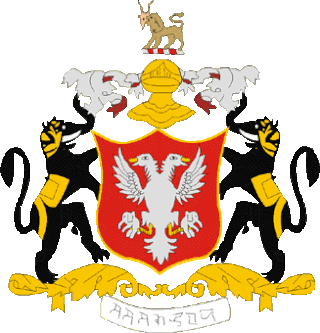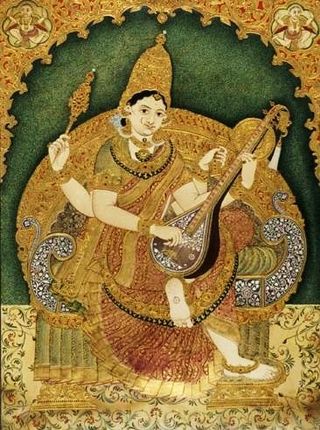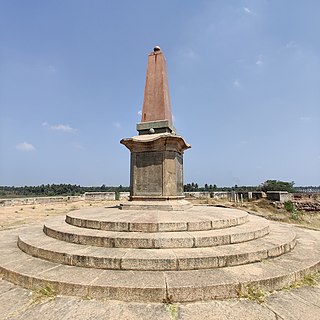
Srirangapatna is a town and headquarters of one of the seven Taluks of Mandya district, in the Indian State of Karnataka. It gets its name from the Ranganthaswamy temple consecrated around 984 CE. Later, under the British rule, the city was renamed to Seringapatnam. Located near the city of Mandya, it is of religious, cultural and historic importance.

The Wadiyar dynasty, is a late-medieval/early-modern South Indian Hindu royal family of former kings of Mysore from the Urs clan originally based in Mysore city.

The Kingdom of Mysore was a realm in southern India, traditionally believed to have been founded in 1399 in the vicinity of the modern city of Mysore. From 1799 until 1950, it was a princely state, until 1947 in a subsidiary alliance with British India. The British took direct control over the princely state in 1831. Upon accession to the Dominion of India, it became Mysore State, later uniting with other Kannada speaking regions to form the state of Karnataka, with its ruler remaining as Rajapramukh until 1956, when he became the first governor of the reformed state.

The Anglo-Mysore Wars were a series of four wars fought during the last three decades of the 18th century between the Sultanate of Mysore on the one hand, and the British East India Company, Maratha Empire, Kingdom of Travancore, and the Kingdom of Hyderabad on the other. Hyder Ali and his succeeding son Tipu fought the wars on four fronts: with the British attacking from the west, south and east and the Nizam's forces attacking from the north. The fourth war resulted in the overthrow of the house of Hyder Ali and Tipu, and the dismantlement of Mysore to the benefit of the East India Company, which took control of much of the Indian subcontinent.

The Fourth Anglo-Mysore War was a conflict in South India between the Kingdom of Mysore against the British East India Company and the Hyderabad Deccan in 1798–99.

Mysore district, officially Mysuru district, is an administrative district located in the southern part of the state of Karnataka, India. It is the administrative headquarters of Mysore division.Chamarajanagar District was carved out of the original larger Mysore District in the year 1998. The district is bounded by Chamrajanagar district to the southeast, Mandya district to the east and northeast, Kerala state to the south, Kodagu district to the west, and Hassan district to the north.

The siege of Seringapatam was the final confrontation of the Fourth Anglo-Mysore War between the British East India Company and the Kingdom of Mysore. The British, with the allied Nizam Ali Khan, 2nd Nizam of Hyderabad and Marathas, achieved a decisive victory after breaching the walls of the fortress at Seringapatam and storming the citadel. The leader of the British troops was Major General David Baird, among the lesser known allies were the Portuguese in Goa and Damaon. Tipu Sultan, the de facto ruler after the death of his father, who had usurped the throne of Mysore, was killed in the action. The British restored the Wodeyar dynasty back to power after the victory through a treaty of subsidiary alliance, Krishnaraja Wodeyar III was crowned the King of Mysore. However, they retained indirect control of the kingdom's external affairs.
The Bangalore Cantonment (1806–1881) was a military cantonment of the British Raj based in the Indian city of Bangalore. The cantonment covered an area of 13 square miles (34 km2), extending from the Residency on the west to Binnamangala on the east and from the Tanneries on Tannery Road in the north to AGRAM in the south. By area, it was the largest British military cantonment in South India. The British garrison stationed in the cantonment included three artillery batteries, and regiments of the cavalry, infantry, sappers, miners, mounted infantry, supply and transport corps and the Bangalore Rifle Volunteers. The Bangalore Cantonment was directly under the administration of the British Raj, while Bangalore City itself was under the jurisdiction of the Durbar of the Kingdom of Mysore.

Mysore painting is an important form of classical South Indian painting style that originated in and around the town of Mysore in Karnataka encouraged and nurtured by the Mysore rulers. Painting in Karnataka has a long and illustrious history, tracing its origins back to the Ajanta Caves period. The distinct school of Mysore painting evolved from the paintings during the Vijayanagara Empire period, the rulers of Vijayanagara and their feudatories encouraged literature, art and architecture as well as religious and philosophical discussions. With the fall of the Vijayanagara Empire after the 1565 Battle of Talikota, the artists who were until then under royal patronage migrated to various places such as Mysore, Tanjore and Surpur among others. Absorbing the local artistic traditions and customs, the erstwhile Vijayanagara school of painting gradually evolved into the many styles of painting in South India, including the Mysore and Tanjore schools of painting.

Krishnaraja Wadiyar III was the twenty-second maharaja of the Kingdom of Mysore. Also known as Mummadi Krishnaraja Wadiyar, the maharaja belonged to the Wadiyar dynasty and ruled the kingdom for nearly seventy years, from 30 June 1799 to 27 March 1868. He is known for his contribution and patronage to different arts and music during his reign. He was succeeded by his adopted son, Chamarajendra Wadiyar X.
The Kingdom of Mysore was a kingdom in southern India founded in 1399 by Yaduraya in the region of the modern city of Mysore, in the Karnataka state. The Wodeyar dynasty, as the ruling family is known, ruled the southern Karnataka region until Indian independence in 1947, when the kingdom was merged with the Union of India. During the Kingdom's history, it went through various phases of administration, with increasing foreign influence from the eighteenth century.

KrishnacharyaPurnaiah, popularly known as DewanPurnaiah, was an Indian administrator, statesman, and strategist who served as the first dewan of Mysore from 1782 to 1811. He was instrumental in the restoration of the rule of the Kingdom of Mysore to the Wadiyar dynasty. After the death of Tipu, he continued to advice Lakshmi Devi, the queen regent to the newly installed monarch Krishnaraja Wodeyar III.
The Mysore Commission, also known as commissioners' rule or simply the Commission Rule, was a period and form of government in the history of the Kingdom of Mysore and the neighbouring province of Coorg from 1831 to 1881 when British commissioners administered the kingdom due to the deposition of Maharaja Krishnaraja Wodeyar III and later due to minority of Yuvaraja Chamaraja Wadiyar X. A board of commissioners constituted the chief executive body and provincial head of the kingdom's government. The commission began with uninstallation of Krishnaraja Wodeyar III as King in 1831 and ended with investing Chamaraja Wadiyar X as King in 1881.

Garrison Cemetery is located in Seringapatam, on the banks of the river Cauvery, about 300m from the Bangalore Mysore Highway. It has about 307 graves of the European officers killed in the final assault on Tippu Sultan in 1799, and their family members. Among the graves, there are 80 graves of the officers of the Swiss ‘de Meuron Regiment’, and the rest of the graves are their family members.

Hale Yedatore, a village in the Krishnaraja Nagara taluk of the Mysore district, Karnataka state, India is located about four kilometers north of the commercially important newly built town of Krishnarajanagara, and about 44 km north-west of the historically important city of Mysore. The name Yedatore derives from two Kannada language words, yeda and tore – a name that arises from the "bend to the left" made by the river at that spot which is considered sacred by Hindus. There are steps leading from the temple down to the bathing areas ("ghats") by the river. Yedatore village was severely damaged in the 1920s from the flood waters of the River Kaveri, prompting the Mysore ruler to build the new town, named Krishnarajanagar, little southerly on an elevated land.

Srirangapatna Fort is a historical fort located in Srirangapatna, the historical capital city of the Kingdom of Mysore in present-day South Indian state of Karnataka. Built by the Timmanna Nayaka in 1454, the fort was modified by later rulers and fully fortified in the late 18th century with the help of French architects. Rulers wanted to protect it against British invaders associated with the East India Company.

The Scott's Bungalow is located in Seringapatam on the banks of the river Cauvery, at about half a mile from the Mysore Gate of the Seringapatam gate. The bungalow was the residence of Col. Scott, an officer of the Madras Army who took part in the Siege of Seringapatam in 1799. The bungalow is associated with the legend and tragedy of Col. Scott. The Deserted Bungalow, a poem by Walter Yeldham that was published in 1875, laments the fate of Scott's Bungalow.

Masjid-i-Ala is a mosque located inside the Srirangapatna Fort in Srirangapatna in Mandya District in Karnataka. It was built in 1786-87, during the rule of Tipu Sultan.

Colonel Bailey's Dungeon in Srirangapatna was the place where Tipu Sultan, ruler of Mysore Kingdom used to imprison all the British officers who were captured during the Anglo–Mysore Wars fought by him and earlier by his father Hyder Ali. Colonel Bailey, also spelled Baillie, fell into Tipu's hands in the Second Anglo-Mysore War at the Battle of Pollilur (1780), and spent several months in the dungeons of Srirangapatna. It is near the burial memorial of Tipu Sultan and is surrounded by gardens on all four sides. Colonel William Bailey (Baillie) was the only British officer who died in that place in 1782 as he could not sustain the inhuman conditions, and so the dungeon was later named after him. In this context it is said that prisoners were tied to fixtures in the stone slab of the dungeon and were immersed in water up to their necks.

Obelisk Monument, also known as the Siege Monument, is a commemorative edifice built in Srirangapatna in the Indian state of Karnataka. It marks the memory of the British officers and native soldiers who lost their lives during the siege of Srirangapatna on 4 May 1799 during the last Fourth Anglo-Mysore war fought during 1798-99 between the British army and the forces of the Mysore Kingdom led by Tipu Sultan. The British army was led by the British General Harris. The memorial was built during the reign of Krishna Raja Wadiyar IV in 1907 as a mark of gratitude by the Wadiyars for getting back their throne from the Sultans.

















